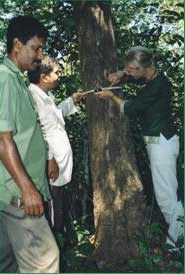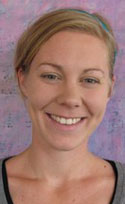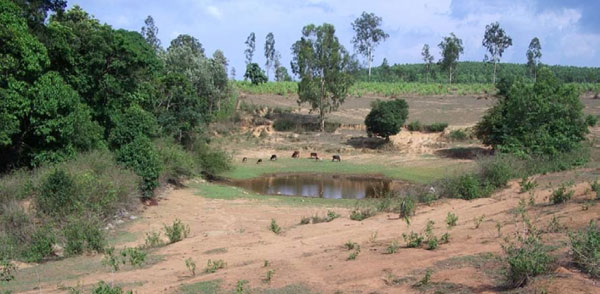SWEDISH SOUTH ASIAN STUDIES NETWORK
Physical geography, Department of Earth Sciences, Göteborg University:
Postal address: Naturgeografi, Institutionen för geovetenskaper, Box 460, SE-405 30 Göteborg
Visiting address: Guldhedsgatan 5A
Web page: http://www.gvc.gu.se/Department_of_earth_sciences/Subjects/Physical_Geography/
Physical Geography is a part of the Dept of Earth Sciences, in which is also included the subjects Geology, Marine geology and Oceanography. Physical Geography and Geography in Developing countries is one of the major reseach fields.
Research connected to South Asia:
Madelene
Ostwald defended her doctoral dissertation on ”Local
protection of tropical dry natural forest, Orissa, India”
on Friday 26 May 2000. Faculty opponent was Dr Freerk
Wiersum, Dept of Forestry, Wageningen University, The Netherlands.
Abstract: Due to the deforestation in tropical areas
where a growing population depends greatly on forest products, local protection
of state-owned natural forest to promote regeneration has emerged as a
form of forest management. The thesis focuses on the effect on forest
and people connected to local forest protection in Orissa, India. It also
explores the possibility of monitoring vegetation change by remote sensing
and tests a support tool system based in a geographical information system.
In the study area, local protection of natural forest promotes regeneration,
without moving the pressure to adjacent forest areas. Large-scale remote
sensing analyses of vegetation index showed a vegetation increase of four
percent from 1992 to 1996 over both the locally protected areas and the
whole forest area. Small-scale analyses showed that with ten years difference
in protection, the forest had developed statistically significant greater
tree diameter, height and succession, while soil properties showed few
differences from only ten years. A remote sensing monitoring study was
conducted using small-scale biophysical data. The result suggests that
a two-class index of high and low vegetation can be statistically distinguished.
The older regeneration area had 59 percent high vegetation, while the
younger regeneration area had 35. The internal variations within two studied
forests show signs of spatial differences related to use in the past.
By combining economic and remote sensing analyses, it was shown that villages
with tree plantations increased regeneration through local protection
in natural forest more successfully than villages without.
Dr. Ostwald is currently on leave from Göteborg University. She spends 80 p.c. of her time working as Assistant Professor at the Centre for Climate Science and Policy Research, a joint venture between Linköping University and the Swedish Meteorological and Hydrological Institute (SMHI) in Norrköping.
She is also a Guest Researcher at the Physical Resource Theory research group within the Dept. of Energy and Environment at Chalmers Institute of Technology, Göteborg, and a member of the Steering Committee of Tellus, a Science Faculty Platform at Göteborg University.
More information on Madelene’s research (in Swedish only).
 Madelene Ostwald has coordinated a major research project titled ”Land use, land-use change and forest (LULUCF) in an extended context beyond Kyoto”, a project that is funded by the International Climate Politics program at the Swedish Energy Agency (STEM).
Madelene Ostwald has coordinated a major research project titled ”Land use, land-use change and forest (LULUCF) in an extended context beyond Kyoto”, a project that is funded by the International Climate Politics program at the Swedish Energy Agency (STEM).
The project included field work in both South India and Sri Lanka (photo to the right from Karnataka) . The other participants in the project were PhD candidates Matilda Palm and Eskil Mattsson in the Dept. of Earth Sciences (more information about them below); Assistant Professor Göran Berndes from the Division of Physical Resource Theory, Dept. of Energy and Environment at Chalmers University of Technology; Prof. N. H. Ravindranath from the Centre for Ecological Sciences, Indian Institute of Science (IISc) in Bangalore, India; Dr. S.P.
Nissanka from the University of Peradeniya, Sri Lanka; and Dr. John Reilly, Senior Lecturer in
Behavioral and Policy Sciences (BPS) at the Massachusetts Institute of Technology (MIT), Cambridge, USA.
Abstract: By means of an integrated approach, tsunami affected land, vegetation and inhabitants were
assessed to evaluate the potential to restore coastal land in the context of Kyoto Protocol’s
Clean Development Mechanism in Hambantota district in the south-eastern part of Sri Lanka.
Firstly, assessments of the status of the tsunami affected area was carried out by collecting
soil- and well water samplings for carbon and salinity analysis. Secondly, identification of
potential tree species for Clean Development Mechanism and biomass measurements of
different forest types was conducted to determine their carbon stock and suitability to grow
under the prevailing soil status. In addition, by performing interviews the local people’s
perception of forest plantations was established.
The results showed that the resilience process
of salt intruded lands from the 2004 Asian tsunami has progressed rapidly. The salinity level
in the soils was low throughout the district but while the well water showed evidence of
salinity contamination. The carbon stock was highest in the mature natural forests and second
highest in coconut plantations. Several land users could imagine expanding their present
plantations or establish new ones. The barriers were defined as lack of financial investment
capital and limited land for extended plantations. If establishing a Clean Development
Mechanism project the coconut tree was found to be the most feasible tree species since it has
a high carbon content and was the also the species that was least affected by the tsunami. It
also possesses a salt-tolerant characteristic that is valuable as well. It was found that the
inhabitants in the study area are dependent of this tree for sustaining a livelihood. Seen from a
Clean Development Mechanism perspective the assessment of multi-functionality of forest
plantations as seen in this tsunami prone area should be considered to increase their
attractiveness of such projects.
In February 2006 Madelene Ostwald received SEK 50 000 as a SASNET planning grant for a project on ”Climate Change and Climate Collaboration between Peradeniya and Göteborg University. The Potential of using CDM (Clean Development Mechanisms) in land and vegetation recovery after the 2004 tsunami in southern Sri Lanka.” The project has been carried out in collaboration with Dr. Nissanka from Faculty of Agriculture, University of Peradeniya, Sri Lanka, with an aim to increase the already flourishing collaboration on education and research between Earth Science Centre, Göteborg University, and Peradeniya. CDM is an abbreviation for Clean Development Mechanism, one of the flexible mechanisms under the Kyoto Protocol. CDM is designed to help developed countries to meet their GHG emission limitation commitments and to assist developing countries to achive sustainable development, while at the same time generate certified emission reductions (CERs) for use by the investor. This includes projects within the field of Sinks projects (afforestation and reforestation). This research project has focused on this, including forests and plantations.
 Dr. Matilda
Palm has been involved in the project on Climate
Change and Climate Collaboration. Her research has focused on forest based CDM
projects in India, impact assessments of present regulation, and
analysis of the prospect for establishment of forest based CDM projects
in southern India.
Dr. Matilda
Palm has been involved in the project on Climate
Change and Climate Collaboration. Her research has focused on forest based CDM
projects in India, impact assessments of present regulation, and
analysis of the prospect for establishment of forest based CDM projects
in southern India.
She defended her doctoral dissertation entitled ”Land Use in Climate Policy – Forest Based Options at Local Level with Cases from India” on Friday 27 November 2009. Faculty opponent was Associate Professor Emily Boyd from the School of Earth and Environment, University of Leeds, UK. More information, with link to full-text thesis.
The thesis was based on fieldwork conducted mostly in the south Indian state of Karnataka, in collaboration with the Centre for Ecological Science and the Centre for Sustainable Technologies at the Indian Institute of Science (IISc) in Bangalore. There she worked under the supervision of Professor N.H. Ravindranath at IISc, and besides she also worked as a consultant for the UK firm Ecosecurities.
Abstract: With India’s large population, an increased pressure on forest and agricultural land indicate a growing demand for environmental services that is sustainable for the future. Fertile agricultural land is limited and with an increased demand for energy production the development expands to degraded lands, the wasteland. About one fifth of India’s total area is classified as wasteland with estimated biomass productivity of less than 20% of their overall potential. Re-vegetation of wasteland can be one way to reclaim the productivity and restore the carbon storage in the soils
 The thesis combines five separate papers and results in an improved understanding of the local, regional and global implications of different initiatives on land use change. It also analyses the environmental and socioeconomic effects of different efforts, both theoretical and practical. The research presented in this thesis was motivated by a perceived lack of local case studies exploring the contexts of climate policy.
The thesis combines five separate papers and results in an improved understanding of the local, regional and global implications of different initiatives on land use change. It also analyses the environmental and socioeconomic effects of different efforts, both theoretical and practical. The research presented in this thesis was motivated by a perceived lack of local case studies exploring the contexts of climate policy.
The results in this thesis confirm that the performance of individual forest-based project activities will depend on local conditions, for example land availability and local acceptance.
Matilda Palm presently works as a post-doc researcher at the Division of Physical Resource Theory within the Dept. of Energy and Environment, Chalmers University of Technoogy. ![]()
She is also connected on a part time basis to the World Agroforestry Centre (ICRAF) as a researcher where she conducts technical coordination of field activities for the project Rewards, Use and Co- Investment for Environmental Services (RUPES) in Vietnam. More information on Matilda Palm’s research.
 PhD candidate Eskil Mattsson works on a doctoral dissertation project titled ”Drivers and monitoring aspects to deforestation/regeneration in developing countries – relation to ongoing climate change negotiations”, and is part of the STEM funded project on Land Use, Land-Use Change and Forestry (LULUCF) described above.
The aim of the project is to investigate monitoring aspects to
deforestation and degradation in developing countries, with a focus on Sri Lanka. Important
PhD candidate Eskil Mattsson works on a doctoral dissertation project titled ”Drivers and monitoring aspects to deforestation/regeneration in developing countries – relation to ongoing climate change negotiations”, and is part of the STEM funded project on Land Use, Land-Use Change and Forestry (LULUCF) described above.
The aim of the project is to investigate monitoring aspects to
deforestation and degradation in developing countries, with a focus on Sri Lanka. Important
methods are to use remote sensing application and forest inventory data and to apply the
findings and their feasibility by following the international climate change negotiations
regarding reducing emissions from deforestation in developing countries (REDD).
Project description:
Tropical deforestation contributes up to 25 % of net annual CO2 emissions. Underlying causes of deforestation may vary from country to country and in time as well in response to social, cultural and economic conditions.
The aim of this project is to contribute to the ongoing debate and negotiations regarding reduced emission from deforestation in developing countries (REDD) within the international negotiations of the United Nations Framework Convention on Climate Change (UNFCCC). There will be three main parts included in the work. I) Add to the sparse knowledge regarding drivers to forest changes (deforestation/regeneration), which requires integrated assessment were empirical data is one key component. II) Contribute to the methodological development (mainly remote sensing) of processes within forests, i.e. the changes from forest to non-intact forest or the other way around. III) Apply findings and their feasibility by following the international negotiations regarding REDD.
To answer the scientific questions, important methods are: field work in developing countries, data collection from a variety of sources, GIS and remote sensing application, and modelling.
Eskil Mattsson defended his MSc thesis at the department in 2004. The thesis was titled ”The potential of using Clean Development Mechanism in land and vegetation recovery after the 2004 tsunami, Hambantota District, Sri Lanka.”
In 2008, he published a report on ”Policy and monitoring aspects on avoided deforestation – towards a post 2012 climate regime” for the Centre for Climate Science and Policy Research in Norrköping.
More information on Eskil Mattsson’s web page.
SASNET - Swedish South Asian Studies Network/Lund
University
Address: Scheelevägen 15 D, SE-223 70 Lund, Sweden
Phone: +46 46 222 73 40
Webmaster: Lars Eklund
Last updated
2010-12-23
